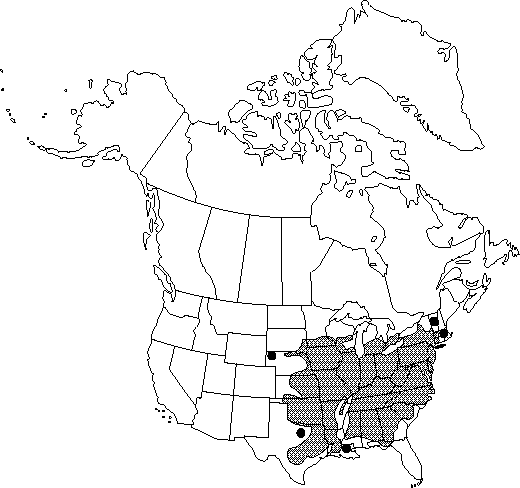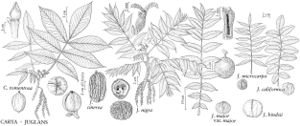Juglans nigra
Sp. Pl. 2: 997. 1753.
Trees, to 40 (-50) m. Bark medium to dark gray or brownish, deeply split into narrow rough ridges. Twigs with distal edge of leaf-scar notched, usually deeply, not bordered by well-defined band of pubescence; pith light-brown. Terminal buds ovoid or subglobose, weakly flattened, 8-10 mm. Leaves 20-60 cm; petiole 6.5-14 cm. Leaflets (9-) 15-19 (-23), lanceolate or ovatelanceolate, symmetric or weakly falcate, (3-) 6-15 × 1.5-5.5 cm, margins serrate, apex acuminate; surfaces abaxially with capitate-glandular hairs, simple or 2-rayed fasciculate hairs, and scales scattered over veins and blade, axils of proximal veins with prominent tufts of fasciculate hairs, adaxially glabrous except for scattered capitate-glandular and fasciculate hairs on midrib; terminal leaflet small or often absent. Staminate catkins 5-10 cm; stamens 17-50 per flower; pollen-sacs 0.8-0.9 mm. Fruits 1-2, subglobose to globose, rarely ellipsoid, 3.5-8 cm, warty, with scales and capitate-glandular hairs; nuts subglobose to globose, rarely ellipsoid, 3-4 cm, very deeply longitudinally grooved, surface between grooves coarsely warty. 2n = 32.
Phenology: Flowering spring (Apr–May).
Habitat: Rich woods
Elevation: 0-1000 m
Distribution

Ont., Ala., Ark., Conn., Del., D.C., Fla., Ga., Ill., Ind., Iowa, Kans., Ky., La., Md., Mass., Mich., Minn., Miss., Mo., Nebr., N.J., N.Y., N.C., Ohio, Okla., Pa., R.I., S.C., S.Dak., Tenn., Tex., Vt., Va., W.Va., Wis.
Discussion
Variation of Juglans nigra in central Texas and south-central Oklahoma should be studied; specimens seemingly intermediate between J. nigra and both J. major and J. microcarpa have been seen from this area. E. C. Twisselman (1967) incorrectly reported that J. nigra was locally naturalized in California; his specimens were all J. hindsii (possibly introgressed with J. nigra) and J. californica.
Juglans nigra is frequently cultivated as an ornamental, and the nuts are prized for their strong, distinctive flavor.
Native Americans used Juglans nigra medicinally as a miscellaneous disease remedy, a dermatological aid, and a psychological aid (D. E. Moerman 1986).
Selected References
None.
